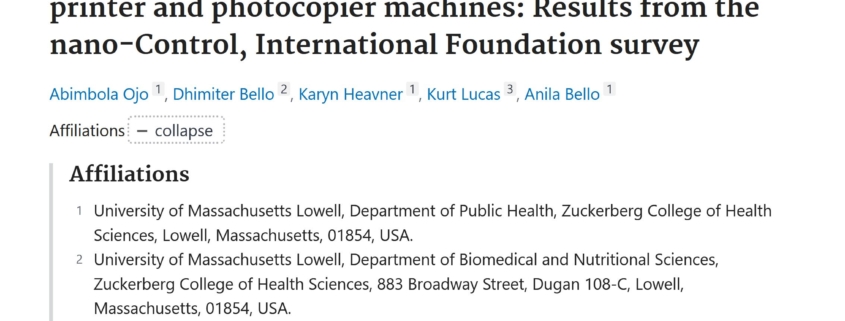Over the course of many years, the International nano-Control Foundation (iNCF) used a detailed questionnaire to carefully and systematically collect information about health symptoms and exposure conditions of office employees who believed to be exposed to printers and photocopier machines in Germany. The data were collected between 1999 and 2010 from at least 2000 participants. After no one in Germany showed any interest on such data for many years, in 2021, a team of researchers from the US University of Massachusetts Lowell in the College of Health Sciences, led by Profs. Dhimiter Bello and Anila Bello, systematically analyzed the data and published the results in the Journal of Occupational and Environmental Medicine[1]. Dr. D Bello’s group has been investigating the chemistry and toxicology of nanoparticle emissions from printers and photocopiers for many years.
The current paper documented that workers who stated that they were exposed to particles from these machines, including copy and printer machine operators, technicians, and office workers, also reported high frequencies of respiratory diseases (90% of 1998 respondents), allergies (70% of respondents), as well as other health symptoms or diseases, including asthma/Chronic Obstructive Pulmonary Disease (COPD, 15% of respondents), bronchial hyperreactivity, cardiovascular disease, neurological disorders, metal allergies (nickel and cobalt), gastrointestinal disorders, and some cancers. The researchers found that half of the workers reported that their acute respiratory and skin conditions improved significantly away from work (e.g. on the weekend or holidays) and worsened when returning to work, indicating an important role of workplace exposures on the reported symptoms.
The “visible toner dust” – a surrogate for printer-emitted particles (PEP) exposures, was a strong predictor of several health outcomes, including chronic fatigue, bronchial hyperreactivity, asthma/COPD and cardiovascular disease, as indicated by the high and statistically significant adjusted odds ratios.
The scientists acknowledge in the paper several limitations related to self-reported qualitative data, the lack of quantitative exposure assessment, and other confounders, and acknowledge that further epidemiologic research is needed to link quantitatively the PEP exposures with adverse health outcomes. However, the most reported health symptoms in this dataset are consistent with limited available and credible studies in animals, healthy volunteers and epidemiologic studies of printing workers. The scientists conclude that to continue to dismiss workers’ concerns as unfounded is not justified. The good news is that simple and cost-effective solutions to reduce or even eliminate PEP exposure already exist and can be easily implemented in a large scale.
Copyright © 2024 American College of Occupational and Environmental Medicine



 nano-control - Playground KI
nano-control - Playground KI
Hinterlasse einen Kommentar
An der Diskussion beteiligen?Hinterlasse uns deinen Kommentar!